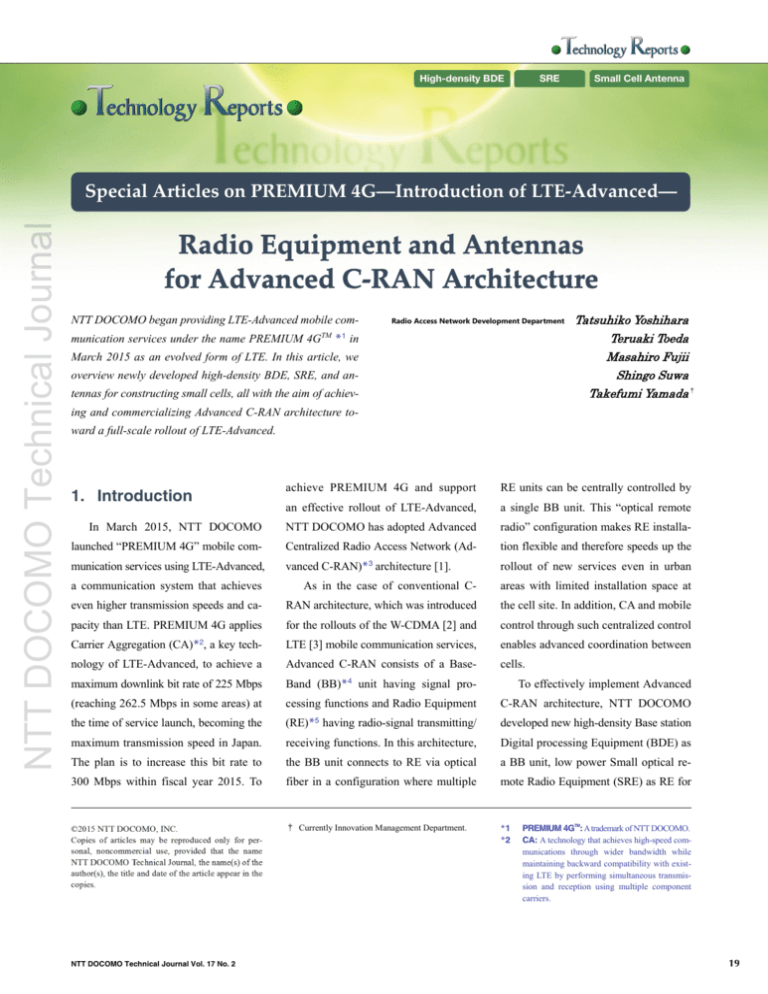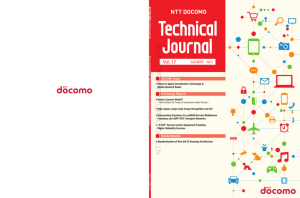Radio Equipment and Antennas for Advanced C
advertisement

High-density BDE SRE Small Cell Antenna NTT DOCOMO Technical Journal Special Articles on PREMIUM 4G―Introduction of LTE‐Advanced― NTT DOCOMO began providing LTE-Advanced mobile com- Radio Access Network Development Department munication services under the name PREMIUM 4GTM *1 in March 2015 as an evolved form of LTE. In this article, we overview newly developed high-density BDE, SRE, and antennas for constructing small cells, all with the aim of achiev- Tatsuhiko Yoshihara Teruaki Toeda Masahiro Fujii Shingo Suwa Takefumi Yamada † ing and commercializing Advanced C-RAN architecture toward a full-scale rollout of LTE-Advanced. achieve PREMIUM 4G and support RE units can be centrally controlled by an effective rollout of LTE-Advanced, a single BB unit. This “optical remote In March 2015, NTT DOCOMO NTT DOCOMO has adopted Advanced radio” configuration makes RE installa- launched “PREMIUM 4G” mobile com- Centralized Radio Access Network (Ad- tion flexible and therefore speeds up the 1. Introduction munication services using LTE-Advanced, vanced C-RAN)*3 architecture [1]. rollout of new services even in urban a communication system that achieves As in the case of conventional C- areas with limited installation space at even higher transmission speeds and ca- RAN architecture, which was introduced the cell site. In addition, CA and mobile pacity than LTE. PREMIUM 4G applies for the rollouts of the W-CDMA [2] and control through such centralized control a key tech- LTE [3] mobile communication services, enables advanced coordination between nology of LTE-Advanced, to achieve a Advanced C-RAN consists of a Base- cells. Carrier Aggregation (CA)*2, maximum downlink bit rate of 225 Mbps Band unit having signal pro- To effectively implement Advanced (reaching 262.5 Mbps in some areas) at cessing functions and Radio Equipment C-RAN architecture, NTT DOCOMO the time of service launch, becoming the (RE)*5 having radio-signal transmitting/ developed new high-density Base station maximum transmission speed in Japan. receiving functions. In this architecture, Digital processing Equipment (BDE) as The plan is to increase this bit rate to the BB unit connects to RE via optical a BB unit, low power Small optical re- 300 Mbps within fiscal year 2015. To fiber in a configuration where multiple mote Radio Equipment (SRE) as RE for ©2015 NTT DOCOMO, INC. Copies of articles may be reproduced only for personal, noncommercial use, provided that the name NTT DOCOMO Technical Journal, the name(s) of the author(s), the title and date of the article appear in the copies. † Currently Innovation Management Department. *1 *2 NTT DOCOMO Technical Journal Vol. 17 No. 2 (BB)*4 PREMIUM 4GTM: A trademark of NTT DOCOMO. CA: A technology that achieves high-speed communications through wider bandwidth while maintaining backward compatibility with existing LTE by performing simultaneous transmission and reception using multiple component carriers. 19 Radio Equipment and Antennas for Advanced C-RAN Architecture small cell*6 use, and base-station anten- BDE, SRE, and base-station antennas remote-radio configuration. It is capa- nas likewise for small cells. An image for small cells. ble of operating in LTE and LTE-Ad- of service area rollout by Advanced CRAN architecture using the above equip- High-density BDE corresponds to the we provide an overview of high-density BB unit in an Advanced C-RAN optical- NTT DOCOMO Technical Journal ment is shown in Figure 1. In this article, RRE (macro cell) High-density BDE equipment has the features showed in Table 1. SRE (small cell) Plane antenna Optical cable Rod antenna (with tilt) Rod antenna (no tilt) Gathering place (public square, station, etc.) Figure 1 Service area rollout by Advanced C-RAN architecture Photo 1 *3 *4 *5 *6 20 vanced simultaneously (Photo 1). This 2. High-density BDE Advanced C-RAN: Network architecture promoted by NTT DOCOMO using CA technology to enable cooperation between macro cells and small cells. BB: The circuits or functional blocks that perform digital signal processing. RE: Radio equipment that connects to BDE via CPRI. Small cell: Generic name for a cell covering a small area and having low transmission power Appearance of high-density BDE relative to a macro cell. NTT DOCOMO Technical Journal Vol. 17 No. 2 NTT DOCOMO Technical Journal 2.1 Increase in Number of Accommodated Cells and Advanced Inter-cell Coordination for adjusting and synchronizing the trans- systems. Here, TDD support requires the mission timing of all connected RE (RRE synchronization of transmission timing and SRE). This makes it possible to per- among all adjacent RE units. High-den- form CA even between REs installed at sity BDE supports GPS and Precision One unit of high-density BDE can different locations or REs having differ- Time Protocol (PTP)*11 as time synchro- accommodate a maximum of 48 optical ent optical cable lengths for connecting nization methods, and synchronization fiber connections each over a Common to the high-density BDE. between high-density BDE units can be Public Radio Interface (CPRI) link*7, achieved through synchronization with GPS either directly or via a PTP network. eight times that of existing BDE [4]. 2.2 Greater Ease of Installation and Longer Optical Connections Centralized control of a large number of High-density BDE makes the instal- transmission path facilitates service ex- cells enables more flexible inter-cell co- lation of equipment easier by signifi- pansion by TDD even in an environment ordination and cell combinations for CA. cantly reducing the installation space and in which GPS antennas—which are or- In addition, this equipment can connect power needed per cell (installation space dinarily used for TDD time synchroniza- to SRE for small cells as well as existing and power consumption approximately tion—are difficult to install, such as un- used in macro cells, one-half and 40%, respectively, that of derground complexes. In addition, high- and thus realize CA with any combination existing BDE). The optical-connection density BDE supports TDD- Frequency of cells without restrictions on frequency length between the BB unit and RE has Division Duplex (FDD)*12 CA [6] with bands or RE types. also been extended by approximately existing FDD bands and 3CC-or-greater To achieve higher peak speeds by 1.5 times that of existing equipment for CA as further extensions of CA. It also CA in a stable manner, receive timing more flexible area expansion and cell supports extension to higher order Mul- difference between Component Carriers accommodation. tiple Input Multiple Output (MIMO)*13 which means a maximum of 48 cells or Remote RE (RRE)*8 (CCs)*9 in the mobile terminal must be kept to within a certain range for either toward the realization of advanced des- 2.3 Future Extendibility macro cells or small cells [5]. The highdensity BDE is equipped with a function *8 *9 ignated base stations in the 3.5 GHz band This high-density BDE also supports [7]. 3G and Time Division Duplex (TDD)* 10 Table 1 *7 This ability to synchronize via a PTP Basic specifications of high-density BDE High-density BDE Existing BDE Supported systems LTE/LTE-Advanced LTE No. of CPRI links Max. 48 Max. 6 Length of optical connection Approx. 1.5 times existing BDE ― Max. downlink speed (per cell) 225 Mbps (30 MHz bandwidth) – 3 Gbps (future support) 50 Mbps (20 MHz bandwidth) Power consumption 125 W (per cell) 200 W (per cell) Size Approx. 1/2 existing BDE (per cell) ― CPRI link: Circuit between BDE and RE conforming to CPRI internal interface specifications for standard radio base stations. High-density BDE can operate a maximum of 48 CPRI links enabling a maximum of 48 RE connections. RRE: eNB antenna equipment installed at some distance from an eNB using optical fiber or other means. CCs: Bundled carriers used for achieving CA. NTT DOCOMO Technical Journal Vol. 17 No. 2 *10 TDD: A bidirectional transmit/receive system. It achieves bidirectional communication by allocating different time slots to uplink and downlink transmissions that use the same frequency band. *11 PTP: A protocol for achieving high-accuracy time synchronization among equipment connected to a network. In this protocol, equipment that delivers time information (Master Clock) synchronizes with GPS, so by having high-density BDE synchronize with the Master Clock, synchronization between high-density BDE units based on GPS time can be performed. *12 FDD: A scheme for transmitting signals using different carrier frequencies and bands in the uplink and downlink. *13 MIMO: Wireless communications technology for expanding transmission capacity by using multiple transmit/receive antennas. 21 Radio Equipment and Antennas for Advanced C-RAN Architecture 3. SRE SRE corresponds to compact, low- NTT DOCOMO Technical Journal making it more advantageous for installa- 16 nent, Transmitter and Receiver (TRX)* tion. Having a small cell radius and low functional component, Transmission-Pow- output power, SRE is conducive to high- Low Noise Ampli- density arrangements and installation on the one-LTE-carrier, one-sector type us- fier (LNA)* (DUP)*19. low-rise buildings relative to RRE and ing a dual-antenna system. It comes in SRE features are summarized below can therefore be used to increase radio two types: equipment supporting the 1.5 (Table 2). capacity. Furthermore, as the maximum output, optical-RRE for small cells of GHz band as a capacity band*14 er Amplifier (T-PA)*17, 18, and DUPlexer transmit power of SRE is less than that and equipment supporting the 1.7 GHz band (Photo 2). 3.1 Compact, Light, and Low-power Configuration of existing RRE, the degree of contribution of the TRX functional component to Similar to existing RRE, SRE con- SRE is smaller and lighter than exist- overall power consumption is relatively sists of a Transmitter and Receiver-INter- ing RRE while consuming less power larger than that of the T-PA functional RRH: Remote Radio Head Photo 2 Appearance of SRE (left: macro cell RRE; right: SRE (3 models)) Table 2 Max. transmit power Basic specifications of SRE 1.5 GHz SRE 1.7 GHz SRE (Reference) Existing 2 GHz RRE 2 W / 15 MHz / branch 2 W / 20 MHz / branch 20 W / 20 MHz / branch No. of branches 2 2 Size Under 3 ℓ Under 13 ℓ Equipment weight Under 3 kg Under 11.5 kg Power consumption Under 30 W Under 220 W Power supply AC 100 V/200 V DC -48 V *14 Capacity band: A band used mainly for increasing radio capacity. *15 TRX-INF: Functional component that converts IQ signals and maintenance and monitoring signals between BB and TRX to CPRI format for transmission along optical fiber. *16 TRX: Functional component having a function for converting input BB transmit signals into RF transmit signals through orthogonal modulation and a function for performing A/D conversion 22 Face (TRX-INF)*15 functional compo- on RF receive signals and converting result to BB receive signals. *17 T-PA: Functional component that amplifies RF transmit signals from TRX to prescribed power levels. *18 LNA: Device that performs initial amplification of signals received from an antenna. The noise level applied at amplification is low and resulting distortion is also low even for a weak received signal. *19 DUP: Device that separates and multiplexes RF transmit signals and RF receive signals and connects to T-PA and LNA. Includes a function for filtering frequency components other than RF transmit components and RF receive components. NTT DOCOMO Technical Journal Vol. 17 No. 2 component. The TRX functional compo- times that SRE receives much interfer- ments into account. nent includes a distortion compensation ence from mobile terminals connected 1) Rod Antenna (Two Types) circuit for suppressing the distortion to the macro cell, SRE still satisfies the components generated during amplifica- required receive dynamic tion by T-PA, so adopting simpler imple- bling high-quality reception. mentations applicable to SRE maximum NTT DOCOMO Technical Journal transmit power for the distortion compensation circuit can reduce power consump- range*20 ena- 4. Base-station Antennas for Small Cells Having an omnidirectional radiation pattern*23 in the horizontal plane, this type of antenna is installed on the wall or ceiling of a building to form a service area in its periphery. Two types of rod antennas have been developed: one with tion. Moreover, while existing RRE adopts Specifications for base-station anten- tilting for an interference-reduction ef- a DC power supply, SRE adopts an AC nas for use with small cells developed fect and the other with no tilting for a power supply that can generally be pro- by NTT DOCOMO are overviewed in compact configuration. The rod antenna vided by a commercial utility to simplify Table 3. with tilting consists of multiple vertically installation in an installation infrastruc- These antennas feature dual polariza- aligned antenna elements, the amplitude ture different than the existing one. Re- tion*21 and can be shared among the 1.5 and phase of each of which is adjusted ducing power consumption in SRE means GHz and 1.7 GHz frequency bands. A to produce an electrical tilt. The tilt angle, less heat dissipation compared to exist- separately developed compact duplexer is however, is predetermined. ing equipment, so in addition to conven- installed between the SRE and antenna to 2) Plane Antenna tional vertical mounting (on a front or separate and combine signals of these This type of antenna has high gain*24 side surface), horizontal mounting can frequency bands. The compact config- while having a unidirectional radiation also be considered since heat will still uration of these antennas simplifies their pattern making it applicable to installa- be able to dissipate. These mounting op- installation. tion on high places like building roofs to tions contribute to ease of installation. When planning a service area by form a service area in a spot-like manner. placing small cells next to each other, A plane antenna can be given a mechan- 3.2 Optimization of Transmitting and Receiving Performance deterioration in signal quality due to ical tilt with a metal fixture to reduce interference between small cells is an interference. There are also cases of operating issue of concern. To resolve this issue, small cells in the same frequency band downward tilting*22 in the vertical plane in an area that overlaps a macro cell. In is effective to reduce the interference In this article, we overviewed high- such a case, SRE transmit power can be caused by that antenna’s signals on adja- density BDE, SRE, and base-station an- increased to maintain each cell’s required cent cells while also to raise the receive tennas for small cells all newly devel- radius. Additionally, since the installation level within the antenna’s own cell. The oped by NTT DOCOMO for imple- height of SRE antennas is lower than end result is improved throughput [9]. menting Advanced C-RAN. Looking to that of existing RRE, the propagation The following summarizes the features the future, we are committed to raising loss between a mobile terminal and the of three types of antennas developed by customer satisfaction even further by base station is less than that of macro NTT DOCOMO taking interference re- increasing transmission speeds and ca- equipment. Thus, while there may be duction and diverse installation environ- pacity in the radio network, such as *20 Dynamic range: The range of input/output signal that can be processed without distortion. *21 Polarization: Direction of electric-field vibration. Vibration of the electric field in the vertical plane relative to the ground is called vertical polarization and that in the horizontal plane is called horizontal polarization. *22 Tilting: Inclination of an antenna’s main beam direction in the vertical plane. There are mechanical tilt systems that physically tilt the antenna and electrical tilt systems that control the amplitude and phase of antenna array elements. *23 Radiation pattern: Expresses the strength of radio waves radiated in different directions. *24 Gain: Relative signal power in the direction of maximum radiation. NTT DOCOMO Technical Journal Vol. 17 No. 2 5. Conclusion 23 Radio Equipment and Antennas for Advanced C-RAN Architecture Table 3 NTT DOCOMO Technical Journal Antenna type 24 Overview of base-station antenna specifications Rod antenna with titling Rod antenna with no tilting (Reference) Macro cell antenna [8] Plane antenna Appearance Frequency band 1.5/1.7 GHz bands 0.7/0.8/1.5/1.7/2 GHz bands Horizontal-plane directivity Omnidirectional Omnidirectional Unidirectional Unidirectional Tilt type Electrical tilt (no remote control support) No tilt Mechanical tilt (no remote control support) Electrical tilt (remote control support) Size (mm) Under φ55×340 Under φ55×150 Under 200×200×60 Under φ200×2,700 through the development of 3.5 GHz, TDD-compatible equipment, and by improving the overall quality of communications. 2007. Vol.17, No.2, pp.36-46, Oct. 2015. [3] Y. Shimazu et al.: “RRE Shared between W- [7] Ministry of Internal Affairs and Commu- CDMA and LTE Systems,” NTT DOCOMO nications (MIC): “On the Enactment of Technical Journal, Vol.12, No.1, pp.29-33, Guidelines for Establishing Designated Jun. 2010. Base Stations for Introducing the 4G [4] Y. Shimazu et al.: “LTE Base Station REFERENCES Equipments Usable with W-CDMA Sys- [1] K. Kiyoshima et al.: “Commercial Devel- tem,” NTT DOCOMO Technical Journal, Mobile Communications System,” Jul. 2014 (in Japanese). [8] T. Yoshihara et al.: “Five-band Base Sta- opment of LTE-Advanced Applying Ad- Vol.13, No.1, pp.20-25, Jun. 2011. tion Antennas for Introduction of 700 vanced C-RAN Architecture—Expand- [5] 3GPP TS36.300 V12.4.0: “Evolved Univer- MHz Band Services,” NTT DOCOMO ed Capacity by Add-on Cells and Stable sal Terrestrial Radio Access (EUTRA) and Technical Journal, Vol.16, No.1, pp.28- Communications by Advanced Inter- Evolved Universal Terrestrial Radio Ac- Cell Coordination—,” NTT DOCOMO cess Network (E-UTRAN); Overall de- Technical Journal, Vol.17, No.2, pp.10-18, scription; Stage 2,” Dec. 2014. 34, Jul. 2014. [9] S. Yoshida, T. Yoshihara, H. Kawai, T. Ihara, T. Takiguchi and K. Yagyu: “Sys- [6] T. Uchino et al.: “Carrier Aggregation tem Capacity Improvement by Appli- [2] H. Ohyane et al.: “Base Station Support- Enhancement and Dual Connectivity cation of Small Cell Antenna Vertical ing IP Transport,” NTT DOCOMO Tech- Promising Higher Throughput and Ca- Tilt,” IEICE Technical Report, AP2014- nical Journal, Vol.9, No.1, pp.7-12, Jun. pacity,” NTT DOCOMO Technical Journal, 47, pp.41-46, Jun. 2014 (in Japanese). Oct. 2015. NTT DOCOMO Technical Journal Vol. 17 No. 2




